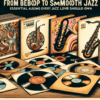Sax, Piano, and Beyond: A Definitive List of Classic Jazz Albums You Can't Miss

Jazz music has enchanted listeners for over a century, evolving in sound and style, interweaving cultures and embracing new influences. The blend of instruments, particularly the saxophone and piano, has played a pivotal role in defining the genre. This article explores some of the most iconic jazz albums featuring these two instruments, offering timeless classics that every jazz enthusiast should have in their library.
The Role of Saxophone in Jazz
The saxophone was invented by Adolphe Sax in the 1840s. Its unique sound, characterized by a rich tone and expressive capabilities, quickly found its place within jazz ensembles. Saxophonists like Charlie Parker, John Coltrane, and Lester Young have become legends, shaping the genre with their innovative techniques and compositions.
Essential Saxophone Albums
Charlie Parker - "Bird and Diz" (1952)
- This collaboration between Parker and trumpeter Dizzy Gillespie showcases the innovative and exciting worlds of bebop jazz. With fast tempos and complex harmonies, the album remains a cornerstone of modern jazz.
John Coltrane - "A Love Supreme" (1965)
- A spiritual suite composed in four parts, this landmark album encapsulates Coltrane's extraordinary improvisational skill. With its deep emotional resonance, "A Love Supreme" is not only essential listening but also a profound experience.
- Ornette Coleman - "The Shape of Jazz to Come" (1959)
- Coleman revolutionized the jazz landscape by introducing the concept of free jazz. His work with the saxophone on this album dismantles traditional harmonic structures, inviting listeners into a new freedom of expression.
The Significance of the Piano
The piano has long been a staple in jazz, employed both as a lead instrument and as part of a rhythm section. Its versatility allows for harmonic richness, intricate melodies, and rhythmic complexity. From New Orleans to modern jazz, pianists have left an indelible mark on the genre.
Essential Piano Albums
See Also: The Evolution of Smooth Jazz: From Miles to Modern Melodies
The Evolution of Smooth Jazz: From Miles to Modern MelodiesThelonious Monk - "Monk's Dream" (1963)
- This virtuoso pianist's unique approach to melody and rhythm shines through in this album. "Monk’s Dream" is characterized by its playful yet complex compositions that capture the essence of Monk's genius.
Bill Evans - "Sunday at the Village Vanguard" (1961)
- Featuring a trio with Scott LaFaro on bass and Paul Motian on drums, this live recording is a standout for its lyrical beauty and intricate interplay among the musicians. The album is a must-listen for anyone wanting to understand the language of jazz piano.
- Chick Corea - "Return to Forever" (1972)
- A fusion of jazz and rock, Corea's album showcases sophisticated arrangements and virtuosic performances. It’s an important work that pushed the boundaries of jazz, merging various influences to create something entirely new.
Beyond Sax and Piano: Jazz Masterpieces
While the saxophone and piano are undeniably central to jazz music, there are countless other instruments and ensembles that have contributed to the genre’s richness. Here are some iconic albums featuring a broader array of jazz configurations.
Essential Albums Featuring Diverse Instruments
Miles Davis - "Kind of Blue" (1959)
- With its modal jazz approach, this album is often regarded as the quintessential jazz record. The ensemble features various instruments, including trumpet, saxophone, and piano, creating a lush soundscape that has influenced musicians for decades.
Duke Ellington - "Ellington at Newport" (1956)
- Capturing the essence of big band jazz, this live performance revitalized Ellington’s career. The album is a celebration of collective improvisation, complex arrangements, and the power of ensemble playing.
- Herbie Hancock - "Headhunters" (1973)
- This groundbreaking fusion of jazz, funk, and rock features an innovative lineup and electronic instruments. Hancock's approach not only broadened the scope of jazz but also attracted a younger audience, ensuring the genre's evolution.
Conclusion: The Importance of Classic Jazz Albums
The albums mentioned above represent a mere fraction of the vast and varied landscape of jazz. The saxophone and piano have served as central components in many of these works, each contributing unique textures and explorative sounds. Listening to these classics goes beyond mere enjoyment: it is an opportunity to understand the historical context of jazz, appreciate its evolution, and grasp the creativity that has inspired generations of musicians.
Jazz is not just music; it is an art form that emphasizes improvisation, collaboration, and emotional expression. The tunes played on a saxophone or the harmonies constructed by a piano serve as a backdrop against which countless stories unfold. By delving into these classic albums, listeners can embark on their own musical journey—one that promises to be rich and rewarding.
FAQs
Q1: Why should I explore classic jazz albums?
See Also: From Bebop to Smooth Jazz: Essential Albums Every Jazz Lover Should Own
From Bebop to Smooth Jazz: Essential Albums Every Jazz Lover Should OwnClassic jazz albums provide insight into the evolution of the genre, showcasing the innovative spirit of musicians. They deliver both historical and cultural context, enriching your listening experience.
Q2: How do I get started with jazz music?
A good starting point is to listen to key albums by influential artists. You can create playlists including songs from the recommended albums or explore streaming platforms that offer curated jazz selections.
Q3: What are some other essential jazz instruments?
Besides saxophone and piano, other key instruments in jazz include trumpet, trombone, double bass, and drums. Each contributes to the genre's expressive qualities.
Q4: Can jazz be enjoyed by everyone?
Absolutely! Jazz is immensely versatile, with styles ranging from smooth to complex. There is likely a subgenre that appeals to almost every musical taste, making it accessible to all listeners.
See Also: Timeless Tunes: The 10 Best Jazz Albums That Shaped Music History
Timeless Tunes: The 10 Best Jazz Albums That Shaped Music HistoryQ5: How does jazz influence other music genres?
Jazz has influenced a multitude of genres, including rock, pop, hip-hop, and electronic music. Its improvisational nature and complex rhythms have left a lasting impact on the music industry, fostering cross-genre collaborations and innovations.
If you want to know other articles similar to Sax, Piano, and Beyond: A Definitive List of Classic Jazz Albums You Can't Miss you can visit the category Jazz.
